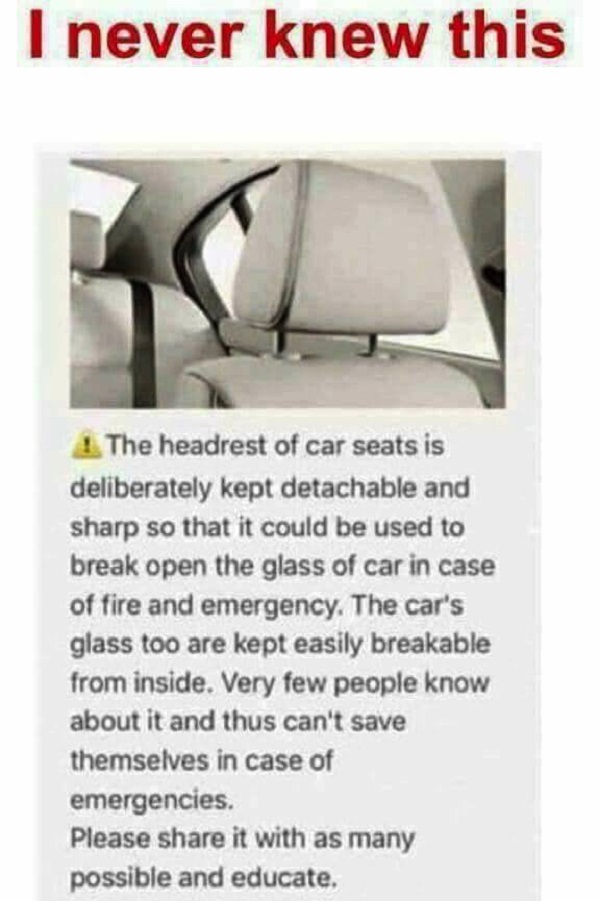
.............................................................................................................................................
Were Car Headrests Designed as Emergency Escape
Tools?
Car headrests were designed for resting heads.
Any other use is incidental to their intended purpose.
DAN EVON
Claim
Car headrests were deliberately designed to be
removed so that they can be used to smash windows during emergencies.
What's True
Car headrests can be used as tools to break
vehicle windows in emergencies.
What's False
Car headrests were not designed to serve this
function.
Origin
In April 2016, a message circulated on Facebook
affirming that car seat headrests were deliberately designed to be detachable
and sturdy so that they could be used to break car windows in emergencies:
This “survival tip” has been around for several
years and has been featured in a number of survival blogs, but it gained
widespread popularity in 2012 when it was featured on a Japanese game show:
The primary intended function of the modern car
headrest was to prevent whiplash in case of accident: When Benjamin Katz filed
a patent for an automobile headrest in 1921, he noted that the device could
stabilize the head when it was subjected to the “jolts and irregular movements”
inherent in driving an automobile.
The car headrest has since gone through many
changes, but these primarily focus on safety, comfort, and manufacturing, not
emergency uses.
Regulations from the National Highway Traffic
Safety Administration regarding head restraints also focus on reducing or
preventing whiplash, not breaking windows.
A NHTSA and Department of Transportation ruling
in 2004 revisited the standards, specifically addressing “Maximum Gap Allowance
and Removability“:
Nissan asserted that there are potential
production difficulties arising from front head restraint non-removability.
Installing a large seat fitted with a head
restraint into a small vehicle, Nissan asserted, might be an arduous task.
 Honda wanted all restraints to be removable by
hand, out of concern that non-removable head restraints would limit seat design
flexibility.
Honda wanted all restraints to be removable by
hand, out of concern that non-removable head restraints would limit seat design
flexibility.
Honda believed that a non-removability
prohibition would prevent it from offering the “fully flat seat” option in its
CRV model vehicle.
DaimlerChrysler concurred with making front seat
head restraints more difficult to remove than rear seat restraints because of
their safety benefits and the absence of a need to remove them for visibility
and functionality reasons.
DaimlerChrysler also agreed that there should be
some means to remove front head restraints for purposes such as seat cover
installation.
However, DaimlerChrysler wanted the word “tool”
to be interpreted as including the mechanism in their current vehicles
requiring two hands to operate.
A majority of industry commenters wanted NHTSA to
allow removability of rear head restraints in the final rule.
Ford believed that removability of rear head
restraints would allow occupants to fold seats to increase space and would
reduce possible incompatibility with child restraints.
Ford stated that while many vehicles are
currently designed with head restraints that are removable by hand, Ford does
not know of any data regarding misuse or improper adjustment of head restraints
caused by hand removability.
DaimlerChrysler believed that NHTSA should permit
rear seat head restraint removability to facilitate increased vehicle utility
and rearward visibility.
Agency response to comments on head restraint
removability: After considering comments, NHTSA decided to allow removability
of head restraints solely by hand.
However, for both front and rear optional head
restraints, removal must be by means of a deliberate action that is distinct
from any act necessary for adjustment.
That is, the “action” required for removal must
be distinct from that required for adjustment.
For example, the head restraint may be removed by
depressing a special button or operating a lever located somewhere on the head
restraint or the seat back.
However, the action involved in adjusting head
restraints must be different.
This insures that head restraints are not
accidentally removed when being adjusted. The new removability requirement uses
language very similar to that in ECE 17, Paragraph 5.13.
We are establishing the new head restraint
requirements to ensure that vehicle occupants receive better protection from
whiplash and related injuries.
To achieve this purpose, the agency wants to take
reasonable steps to increase the likelihood that a head restraint is available
when needed.
If head restraints were too easily removable,
chances are greater that they will be removed.
That, in turn, increases the chances that the
restraints might not be reinstalled correctly, if at all.
By prohibiting removability without the use of
deliberate action distinct from any act necessary for adjustment, the
likelihood of inadvertent head restraint removal will be reduced, thus
increasing the chances that vehicle occupants will receive the benefits of
properly positioned head restraints.
The ability to break windows in case of emergency
was not mentioned anywhere in this discussion, and the major industry concerns
appeared to be visibility and whiplash prevention.
Federal Motor Vehicle Safety Standard 202 does
not require automakers to manufacture head restraints specifically so that they
can be used to break windows in emergencies.
While some can potentially be used that way, they
are not designed with that specific purpose in mind.
BY DAN EVON
When
misinformation obscures the truth and readers don’t know what to trust,
Snopes.com’s fact checking and original, investigative reporting lights the way
to evidence-based and contextualized analysis. We always document our sources
so readers are empowered to do independent research and make up their own
minds.
Snopes
got its start in 1994, investigating urban legends, hoaxes, and folklore.
Founder David Mikkelson, later joined by his wife, was publishing online before
most people were connected to the internet. As demand for reliable fact checks
grew, so did Snopes. Now it’s the oldest and largest fact-checking site online,
widely regarded by journalists, folklorists, and readers as an invaluable
research companion.
Snopes.com
is an independent publication owned by Snopes Media Group. Explore our FAQ to learn more about
us, or consider becoming a Snopes member. If you have any questions,
please let us know.

No comments:
Post a Comment